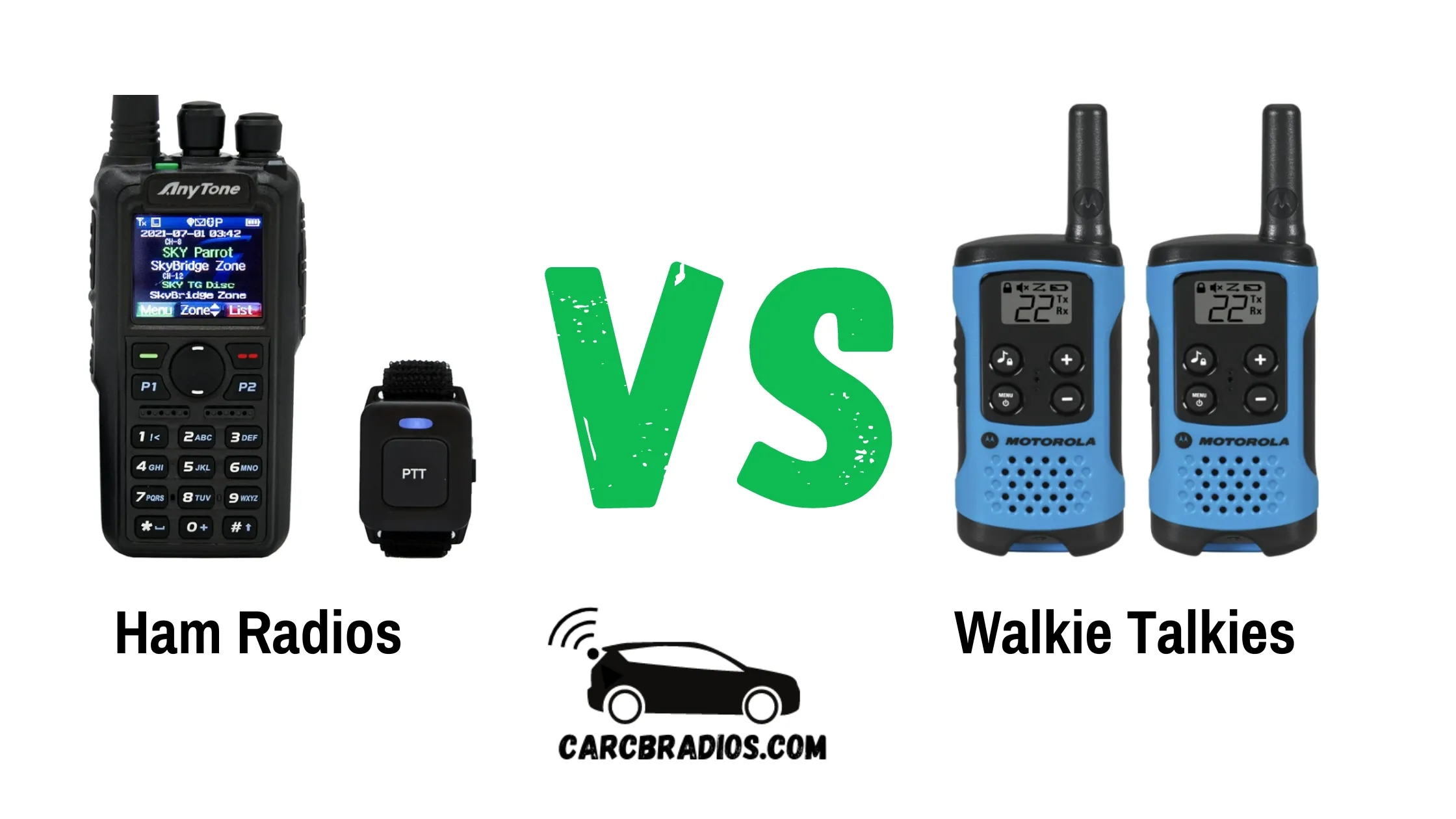By: Jeremy Neisser
When it comes to communication devices, there are a variety of options available, each with their own set of advantages and disadvantages. One comparison that often arises is between ham radios and walkie-talkies. While ham radios are typically considered the superior device, there are certain situations where a walkie-talkie might be the better choice. In this article, I will explore the differences between the two devices and help you determine which one is right for your needs.
Ham radios and walkie-talkies both have their own unique features and benefits, and it's important to understand these differences before making a decision. By the end of this article, you will have a better understanding of the advantages and disadvantages of each device, and be able to make an informed decision about which one is the best fit for your specific needs.
Key Takeaways
Ham radios and walkie-talkies each have their own set of advantages and disadvantages.
Understanding the differences between the two devices is important when deciding which one to use.
Ultimately, the choice between a ham radio and a walkie-talkie will depend on your specific needs and circumstances.
What is a Walkie-Talkie?
A walkie-talkie is a portable two-way radio communication device that allows users to communicate with each other wirelessly. These devices are commonly used in recreational activities such as hiking, sports leagues, and outdoor activities.
Most consumer-grade walkie-talkies operate on Family Radio Service (FRS) channels between 462 MHz and 467 MHz. However, some devices utilize General Mobile Radio Service (GMRS) which can operate on Ultra High Frequency (UHF) and Very High Frequency (VHF) bands. GMRS radios are often used for more professional applications and can boast a transmission range of 5-10 miles under perfect conditions.
Traditional FRS radios, which are what most people think of when they hear “walkie-talkies,” are generally low-power devices that run on AA or AAA batteries. Their limited power restricts their range to approximately 1-2 miles under the best conditions.
It's worth noting that walkie-talkies are strictly amateur, unregulated, and don’t require a license or registered call sign for operation. All you need to do is purchase, unpack, and switch them on.
In summary, a walkie-talkie is a portable two-way radio communication device that is primarily used for recreational activities. They operate on FRS channels and are low-power devices that run on AA or AAA batteries. It's important to note that GMRS radios are often used for more professional applications and have a longer transmission range.
What are the Benefits of Walkie-Talkies?
Walkie-talkies are an affordable and durable communication solution. They are also beginner-friendly, requiring minimal instruction or training. Unlike ham radios, walkie-talkies don't require a course or license to operate, except on GMRS frequencies. This makes them an accessible option for those looking for a quick and easy way to communicate.
What Are the Drawbacks of Walkie-Talkies?
As a low-power communication device, walkie-talkies have limited range and reliability for transmitting voice communications beyond 1-2 miles, making them less effective in emergencies. Additionally, they have access to a limited number of frequency bands compared to ham radios, which can hinder their ability to communicate in crowded areas or during emergencies.
What is a Ham Radio?
As an amateur radio or ham radio, it is a communication device that operates similarly to a GMRS radio but with more capabilities. Unlike walkie-talkies, which are limited to a few frequencies, ham radios can access any frequencies in the 70 cm band and beyond, making them more versatile. They come in different formats, including handheld, mobile, and base station, and are significantly more powerful, allowing them to communicate over long distances.
To use a ham radio, you must obtain a Technician's license from the Federal Communications Commission (FCC). While handheld ham radios are not as powerful as other mobile or base station ham radios, they still significantly outperform walkie-talkies. They use relatively low power of about 5-8 watts, making them ideal for short-range or near-distance communication.
Ham radios can broadcast thousands of miles away with the added advantage of using repeaters to extend their range. Handheld ham radios are the most likely option to be compared with walkie-talkies, making them an excellent choice for those looking for more powerful communication devices.
What are the Advantages of Ham Radio?
As compared to walkie-talkies, handheld ham radios have a significantly greater range and power. A walkie-talkie can transmit up to 2 miles with perfect conditions, whereas a handheld ham radio can transmit much farther due to several factors.
With an excellent line of sight, optimal weather conditions, and no obstructions, a handheld ham radio can achieve a range of 12-20+ miles. However, the range may reduce to approximately 2 miles in poor climate conditions or with obstructions like hills, mountains, or buildings. These are the primary factors that impact the range of handheld ham radios.
Moreover, the range of a handheld ham radio can be extended by upgrading its antenna. Most handheld transceivers come with “rubber ducky” antennas, which offer limited power and transmission capabilities. Upgrading to a stronger antenna can improve the range up to 20 miles in some cases.
Power is another factor that can impact the range of a handheld ham radio. Most handheld ham radios have a power output of 5-8 watts, with some models going higher. However, the extra power doesn’t always translate into more range for handhelds. Line of sight and antenna quality have the biggest impact on the range of a handheld ham radio.
Overall, the advantages of a handheld ham radio over a walkie-talkie are clear: a greater range and power, with the ability to extend the range even further with upgraded antennas.
What are the Drawbacks of Ham Radio?
As an avid ham radio user, I can attest to the fact that there are few downsides to this hobby. However, it is important to note that obtaining a ham radio license from the FCC is required before operating a ham radio, unlike with walkie-talkies. This additional step has deterred some individuals from pursuing the hobby. Additionally, proper training and practice are necessary to use ham radios effectively.
While ham radios can access a wider range of frequencies than walkie-talkies, it is important to note that the use of GMRS and FRS frequencies is prohibited for ham radio operators, although some still attempt to use them.
Why Use a Ham Radio?
As a radio enthusiast or professional, using a ham radio provides a versatile option for communication across the world. Ham radios offer high power and long-range capabilities, making them valuable for emergency communications in times of natural disasters or when infrastructure is down and power is out.
One of the most significant advantages of ham radios is their ability to pick up various types of signals, including FM radio broadcasts, Morse code, weather updates from the NOAA, maritime and aviation transmissions on the VHF band, and many emergency responder channels. This wide-ranging ability to tune into critical communications makes ham radios a top choice for those planning for emergencies.
In summary, using a ham radio provides a reliable and flexible option for communication in emergency situations and beyond.
Frequently Asked Questions
What are the differences between ham radios and walkie talkies?
Ham radios and walkie talkies are both two-way communication devices, but they differ in their intended use, range, and power. Ham radios are designed for long-range communication and require a license to operate, while walkie talkies are intended for short-range communication and can be used without a license.
What are the advantages of using a ham radio over a walkie talkie?
Ham radios have many advantages over walkie talkies, including longer range, more power, and access to a wider range of frequencies. Ham radios can also be used to communicate with other ham radio operators around the world, making them a valuable tool for emergency communication and disaster response.
What are the advantages of using a walkie talkie over a ham radio?
Walkie talkies are more portable and easier to use than ham radios, making them ideal for short-range communication in areas where a ham radio would be impractical. Walkie talkies are also less expensive than ham radios and do not require a license to operate.
What are some important frequencies to know for ham radio use?
Ham radio operators have access to a wide range of frequencies, but some of the most important include the 2-meter band (144-148 MHz) and the 70-centimeter band (420-450 MHz). These frequencies are commonly used for local communication and emergency response.
What are some important frequencies to know for walkie talkie use?
Walkie talkies typically operate on the Family Radio Service (FRS) or General Mobile Radio Service (GMRS) frequencies, which range from 462-467 MHz. It's important to know which frequencies are legal to use in your area and to avoid interfering with other users.
What are some common uses for ham radios and walkie talkies?
Ham radios are commonly used for emergency communication, disaster response, and long-range communication with other ham radio operators. Walkie talkies are often used for short-range communication in outdoor activities such as camping, hiking, and skiing, as well as in commercial settings such as construction sites and warehouses.

Hi & Welcome!
My name is Jeremy and I have been an avid car nut for many year. My first car was an 1987 Honda CRX. I put in my first Kenwood stereo, amp, 2 10" JLs and a CB Radio in it and have been an avid user of CBs and car radios for years. I'll do my best to share my tips, information and thoughts to help you with whatever question you might have, ABOUT ME
After I graduated from High School, I worked 5 years are Radio Shack and 3 years at Circuit City answering questions and helping customers with various electronics questions.

